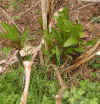| 4-18-05
It hasn’t happened yet in central and northern parts of the state, but
two of my favorite “harbingers of spring” are about ready to pop. That
translates into some great table fare.
The exciting emergences to which I refer are wild asparagus and pokeweed.
Although neither of the two has poked up through the earth as this column
is taking shape, both should bless the countryside with their presence
before we meet again in this space. If my alarm clock is set a tad early,
keep looking--patience will pay big dividends.
Both plants are perennials, of course, and both feature tuberous-like
root systems from which their new growth springs each year. Of the two,
wild asparagus is by far the more difficult to find because it most often
is surrounded by other weeds that start their growth earlier and hide the
short, tender shoots.
For this reason, it is wise to locate roadside clusters of wild asparagus
in the fall and make maps of their location before destroying the old growth
in an attempt to hide the location of the plant from others. However, those
who have not mapped favorite clumps of asparagus in the fall, still can
find the tender shoots of the plant by looking for old stalks that were
not destroyed by other asparagus lovers or by winter weather.
Once patches have been located, the tender spears can be harvested by
cutting them at ground level, and waiting a few days for new growth. Eventually,
though, the clusters of spears should be permitted to continue their growth
to maturity to perpetuate the patch.
Pokeweed also often is hidden by other weeds, but the old stalks from
the previous year is far more durable than those of asparagus, and are
easier to spot at this time of year. Poke stalks often are more than an
inch in diameter and more than six feet tall.
Poke is harvested by cutting off the shoots when they are two to six
inches above the earth. Poke shoots may also be harvested several times
without endangering the regenerative powers of the plant. Eventually, though,
the plants should be permitted to mature.
There are many ways to prepare wild asparagus and poke for the table,
but generally applications for wild asparagus cookery follows lines for
vegetables. Poke may be used in dishes of greens, but it can also be steamed
to tenderness, dipped in a mix of egg and milk, dredged in cracker
crumbs or flour (or a mix of the two) and fried. Fried poke shoots are
known in Southern Indiana as “the poor man’s morels” because they taste
much the same.
Additional information on cooking wild asparagus and poke shoots will
be found by searching this web site.
Click
on thumbnail image for enlarged view.

|
Poke
shoots (note dark green new growth) will appear near old stalks (lighter
colored dead growth) |
| Asparagus
spears are harvested by cutting them off at ground level with a sharp knife
. . . note stumps . . . new spears will appear in a few days. |

|
NEW IKES BOOKLETS--The Izaak Walton
League has released two publications intended to inspire, engage, and assist
outdoor journalists to reacquaint themselves with the potentially explosive
consequences for natural resources of human population growth.
The first volume is, Population Growth and Outdoor America: Outdoor
Writers' Perspectives, a collection of essays by five journalists
on the effects of population growth on outdoor recreation. The companion
piece, An Outdoor Writer's Guide to Population Issues, gives
background information and tips on writing stories about population growth
and getting them published. The publications can be downloaded from the
Izaak Walton League website at:
http://www.iwla.org/sep/pubs/outdoorjournalistguide.pdf
and
http://www.iwla.org/sep/pubs/populationgrowth.pdf
Chuck Clayton, national president of the Ikes, says a number of outdoor
writers have addressed this issue and done so admirably. “Yet, we believe
that hunters, anglers and all outdoor recreation enthusiasts will understand
more fully the consequences of human population growth on their pursuits
when a broader spectrum of journalists start addressing the issue as a
matter of course,” said Clayton.
“Every major threat to outdoor recreation—from climate change to hunting
access, from habitat loss to dying fisheries—is, at its base, an issue
about how people can continue to thrive while maintaining a livable world,”
said Jim Baird, director of the League’s Sustainability Education Project.
He added that “it’s a problem that is real and a story we think outdoor
journalists should embrace more aggressively.”
|

